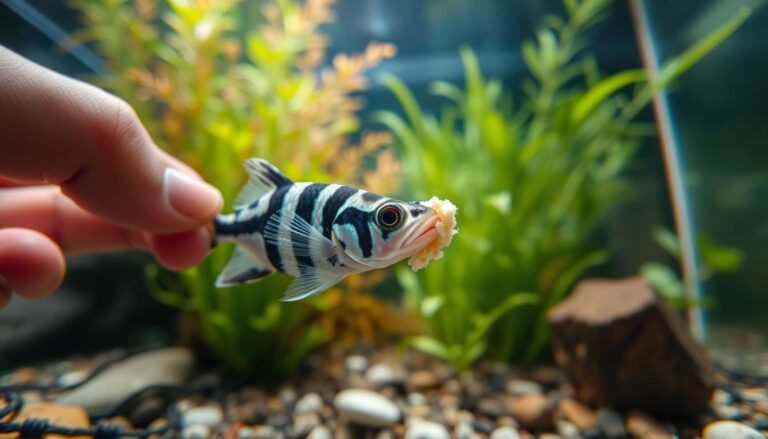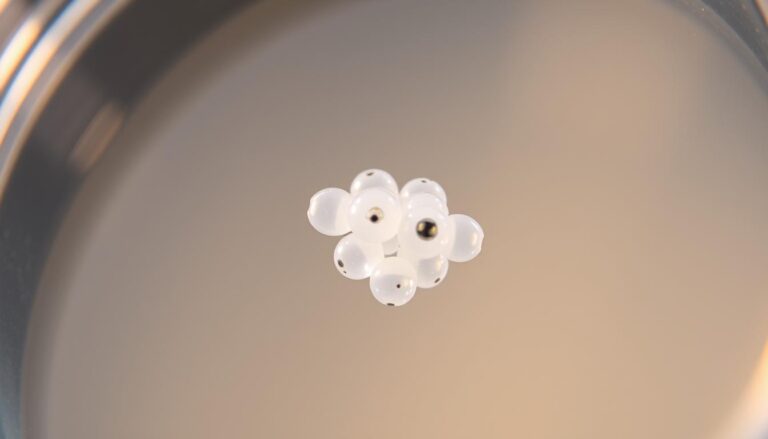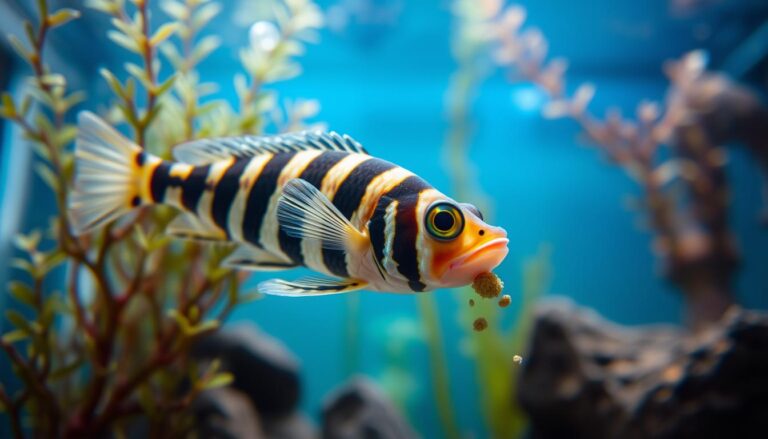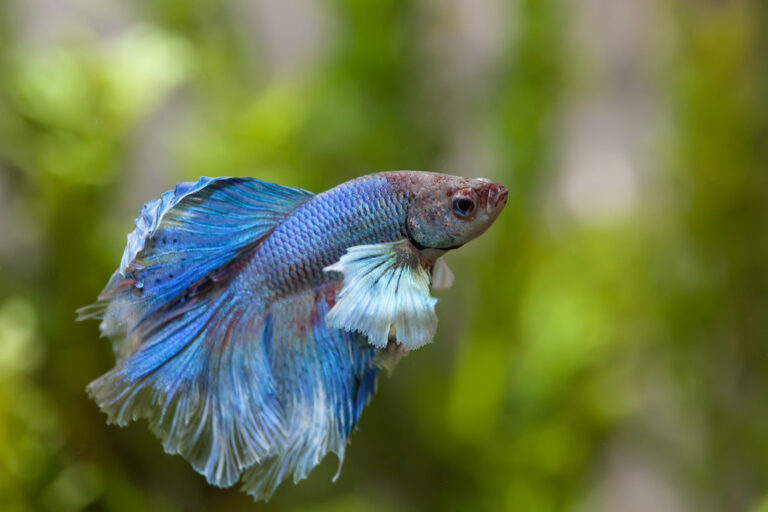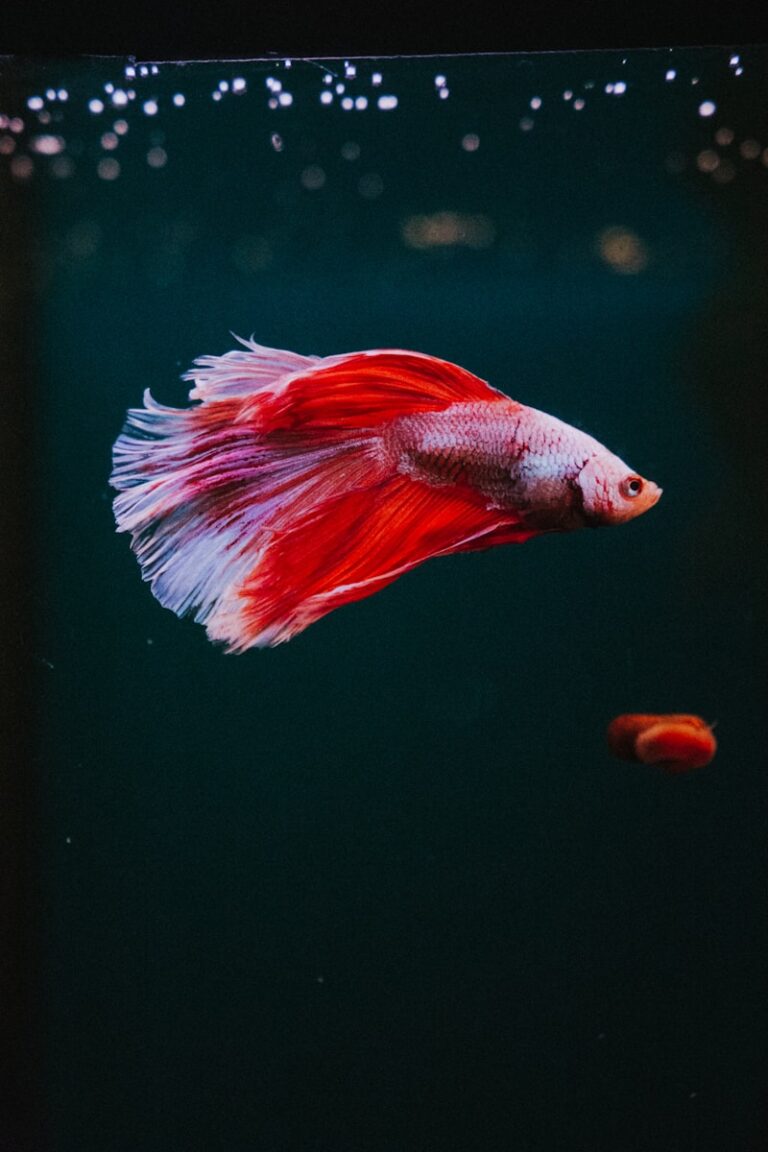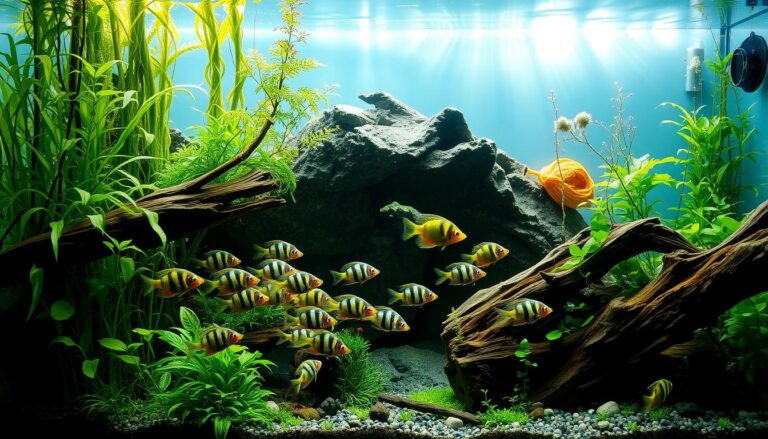Zebra Danio Eggs: Expert Tips for Successful Hatching
Zebra danio eggs are a fun project for aquarium fans. These tiny, golden embryos bring joy to danio breeding. Zebra danios are known for their bright stripes and active nature. They are perfect for both new and experienced aquarists.
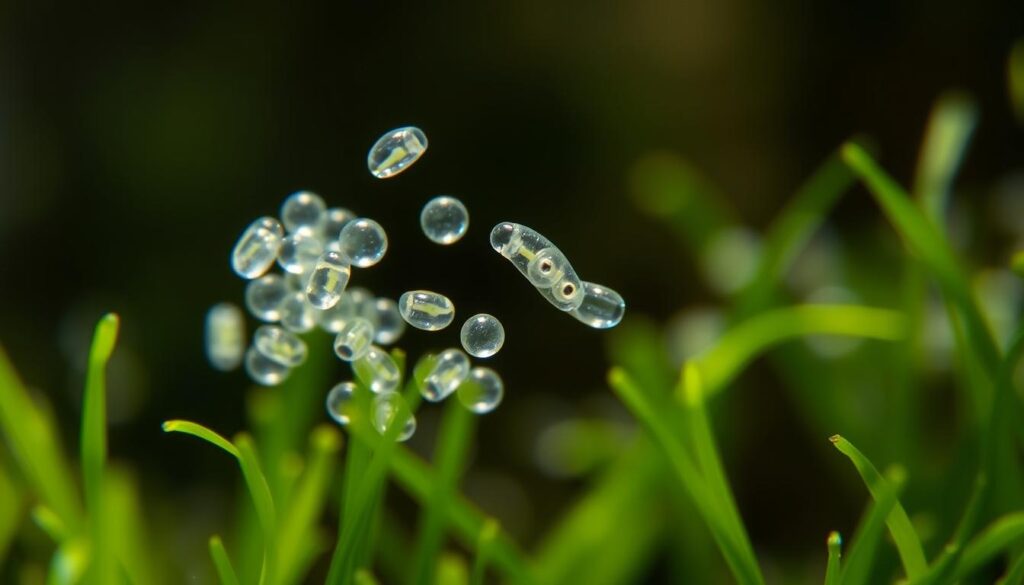
Raising zebra danio eggs needs careful attention to water and breeding habits. Problems like fungal growth or unfertilized eggs can happen. But, with the right steps, breeding in your aquarium can be successful. This guide offers tips to increase hatching rates and help fry survive.
Small changes in your tank or water can make a big difference. Whether you’re setting up a breeding tank or using spawning mops, these tips will help. Seeing eggs turn into swimming fry is a highlight for any fish lover.
Table of Contents
Key Takeaways
- Optimal water temperature speeds fish egg hatching.
- Separating parents prevents egg-eating behavior.
- Regular tank checks reduce fungal infections on eggs.
- Spawning mops mimic natural habitats for successful laying.
- Patience and observation are key to aquarium breeding success.
Understanding Zebra Danio Eggs: Characteristics and Biology
Learning about zebra danio eggs is exciting. These tiny eggs are full of life and interest. Let’s explore their biology together.
Identifying Healthy Zebra Danio Eggs
Healthy fish eggs are translucent or yellowish with a visible embryo. Stay away from eggs that look opaque, white, or fuzzy. These eggs are not healthy. Use a magnifying glass to count the eggs every day. Here’s what to look for:
- Healthy: Clear or light-colored with dark eyespots forming
- Risk: Fungal growth (white mold-like patches)
- Quantity: Females can lay 50–200 eggs daily during spawning
The Life Cycle from Egg to Fry
After egg fertilization, embryos grow fast. Here’s their growth timeline:
- 0–24 hours: Cell division begins
- 24–48 hours: Heartbeat visible through embryo
- 48–72 hours: Fry hatch, seeking upward
These tiny fry cling to plants until they can swim freely. Their transparent bodies make them great for research, as shown by studies on human disease models.
Natural Spawning Behavior in Zebra Danios
In the wild and tanks, danio reproduction has clear patterns. Males chase females near plants like java moss. Important behaviors include:
- Females releasing eggs in batches
- Males releasing milt to fertilize externally
- Parents often ignore eggs post-spawning
Adding broad-leaf plants encourages natural danio spawning. It helps them feel like they’re in their natural habitat.
Creating Optimal Conditions for Zebra Danio Egg Development
For zebra danio eggs to hatch well, they need the right conditions. These conditions should be like their natural home. Water, space, and light must all be just right for growth. Here’s how to make a great environment from the start.
Water Parameters: Temperature, pH, and Hardness
Keep the water temperature between 78°F and 82°F. The pH should be neutral, between 6.8 and 7.8. Soft to moderately hard water (50-150 ppm) is best for growth. Use a thermometer and test kits weekly to check these water parameters.
Big changes in these can stress the eggs. This can lower the chances of them hatching.
Tank Setup and Spawning Mops
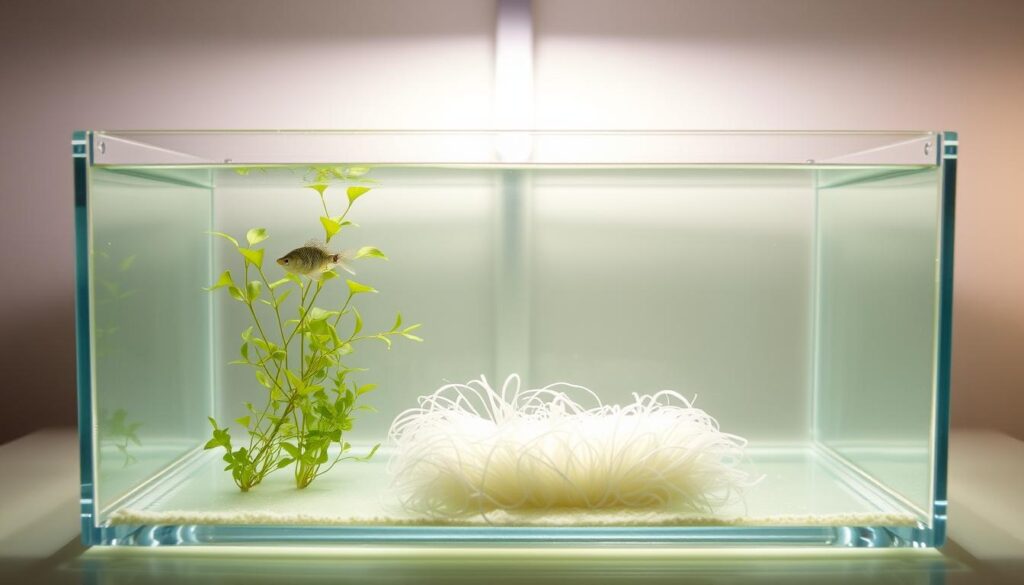
A 10-gallon tank is a good size for most setups. Use a sponge filter to keep eggs safe. Add spawning mops or live plants like java moss for the eggs to stick to.
Place the mops vertically to let oxygen flow. Remove gravel to prevent clouding the water. Here’s a quick checklist:
- Use a 10-20 gallon tank
- Install sponge filters
- Add spawning mops or plants
Lighting Considerations for Egg Development
Give the eggs 12 hours of soft light each day. Stay away from bright LED or direct sunlight to avoid overheating. A shaded corner of the tank is best for keeping eggs safe while still being easy to watch.
Preventing Fungal Infections in Egg Clusters
Act quickly to stop egg fungus prevention problems. Add 1 tsp of methylene blue per 5 gallons if you see spots. Remove moldy eggs daily to stop the fungus from spreading.
Move eggs to a quarantine container after they’re laid to reduce contamination. Regular water changes (25% weekly) help keep ammonia levels low. This reduces the chance of infections.
The Hatching Timeline: What to Expect When Breeding Zebra Danios
Watching the hatching timeline of zebra danio eggs is exciting. Eggs usually hatch in 1.5 to 2 days. But, the temperature matters a lot. Warmer water (78–80°F) makes them hatch faster, while cooler water makes it take longer.
Use a microscope or magnifying glass to see the embryos grow. It’s a fascinating sight.
- Day 1: Eggs change from clear to amber. You can see tiny black eyespots and curved embryos in just 24 hours.
- Day 2: Fry’s heartbeats become visible. They usually hatch by 48–54 hours, then cling to tank surfaces.
- Post-Hatch (Days 3–5): Fry start to grow after hatching. They absorb their yolk sacs and begin swimming in 2–3 days, ready for their first food.
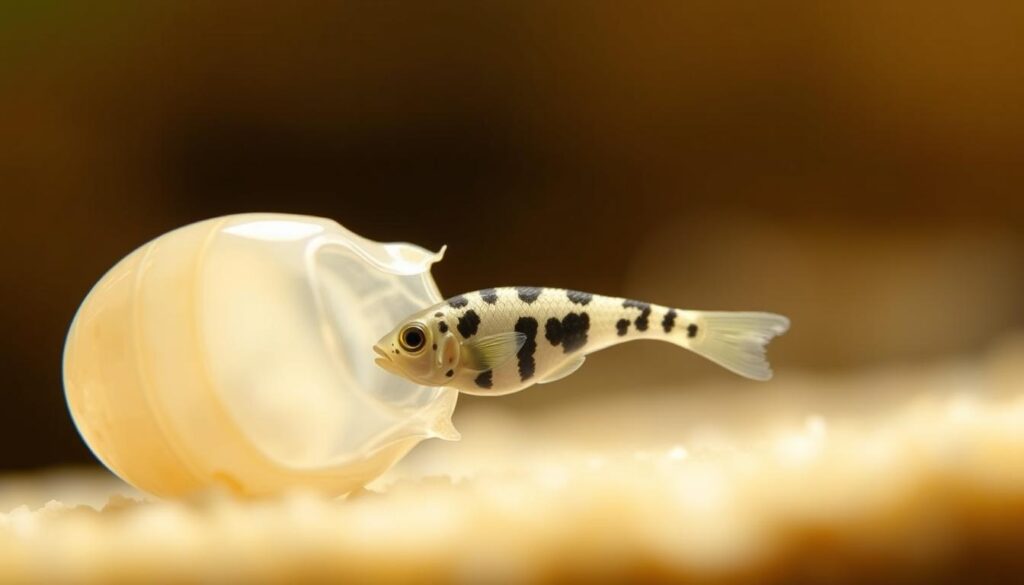
Being patient is important—only 60–70% of eggs survive. Watch for white fungus on eggs, which means they have an infection. You need to treat it fast.
For tips on breeding, check out this guide. If hatching is slow, try adjusting the water temperature. But don’t change it too much. Seeing tiny fry is a big success—enjoy these moments!
Troubleshooting Common Problems with Zebra Danio Eggs
Raising zebra danio eggs comes with its own set of challenges. Let’s tackle the most common problems and find solutions to keep you on track.
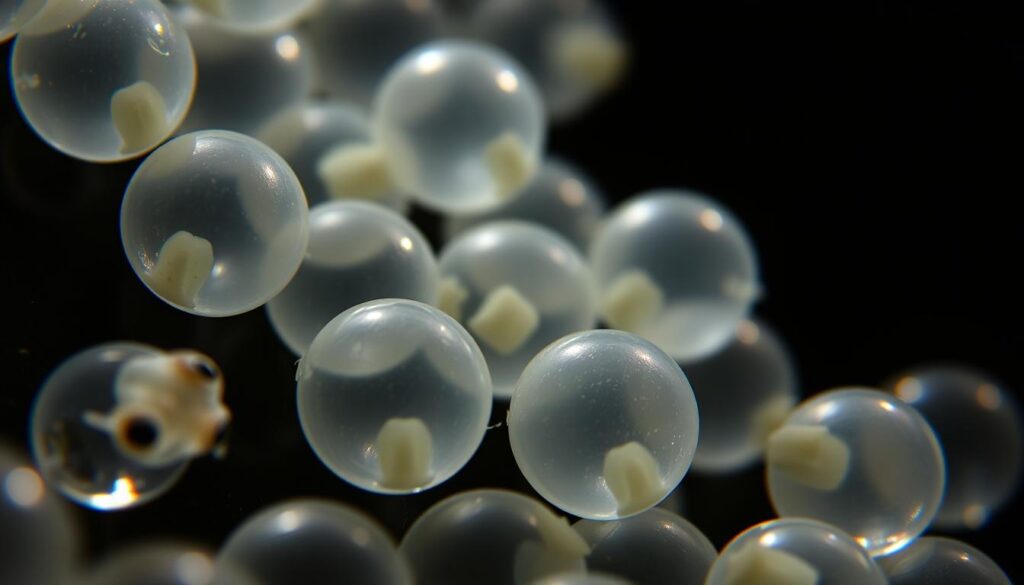
Why Eggs May Not Be Fertilized
Unfertilized eggs look white and opaque. They might be due to old parents, bad food, or not matching pairs. To improve fertilization:
- Feed breeding pairs high-protein foods like brine shrimp.
- Make sure males and females are healthy and over 6 months old.
- Change spawning mops often to reduce stress during courtship.
Dealing with Egg-Eating Fish
Egg-eating fish is a natural behavior. To stop it:
- Take parents away right after they spawn.
- Use spawning mops or mesh containers to keep eggs safe.
- Add floating plants to hide eggs from fish.
Treating Fungus and Infections
White fuzzy stuff on eggs means fungus on fish eggs. Act quickly:
For light cases, soak eggs in 1:20 hydrogen peroxide for 5 minutes. For serious infections, use 1–2 drops of methylene blue per liter. Change the medicine every day until the eggs are clear.
Rescuing Failing Hatches
If eggs get cloudy or don’t hatch, check the water first. Make sure pH is 6.5–7.2 and temperature is 75–80°F. For tough cases, move eggs to a new container with soft air flow.
Remember, every problem is a chance to learn. Stay patient and make small changes. They can make a big difference!
Conclusion: Success Strategies for Zebra Danio Breeding
Starting with zebra danio eggs care means paying close attention to details. Healthy spawns need stable water conditions. Keep the temperature between 75–80°F and the pH level neutral.
Spawning mops or plants help eggs stay safe. Regular water changes stop fungus from growing. These steps are key to successful fish breeding.
Watching how the parents behave is important. Separate them after they lay eggs to stop them from eating the eggs. Keeping a record of each step helps you learn and improve.
Raising danio fry takes patience. Feed them tiny food like infusoria or commercial fry food right after they hatch. As they grow, give them more space in the tank. This helps them stay healthy and strong.
Here’s a quick checklist for success: check the water quality every day, use spawning mops, remove the parents after they spawn, and keep a breeding log. These tips make breeding easier for all hobbyists.
Breeding zebra danios is rewarding. Even with setbacks, you get better with each try. Share your journey with others to get tips and stay motivated. Celebrate every small success, like a successful hatch, to keep going.
Whether you’re new or experienced, these strategies help you build a strong foundation. Focus on the basics, adapt as you go, and enjoy the process. With time, your skills and fish population will grow, creating a thriving aquarium.
FAQ
What do healthy zebra danio eggs look like?
Healthy zebra danio eggs are clear or translucent. You can see a developing embryo inside. Unhealthy eggs might look opaque, white, or have fungus. Watching the eggs’ appearance helps ensure a successful hatch.
How long does it take for zebra danio eggs to hatch?
Zebra danio eggs hatch in 48 to 72 hours. This depends on the water temperature and conditions. Look for signs like eyes and heartbeat to know hatching is near.
What water parameters are optimal for zebra danio egg development?
For egg development, keep the water at 78-82°F. The pH should be between 6.8-7.8, and hardness should be right. These conditions are key for healthy eggs and fry.
How can I prevent fungal infections in zebra danio eggs?
Use antifungal treatments like methylene blue on the eggs. Also, keep the eggs in the best water conditions. Separate them from parents to reduce stress and contamination.
What should I do if my zebra danio eggs are not fertilized?
If eggs aren’t fertilized, check the parents’ age and health. Also, make sure they’re compatible. Improving these factors can help with future fertilization.
How can I stop parents from eating their zebra danio eggs?
Use tank dividers to keep fish apart during breeding. Or remove parents right after spawning. Changing their environment can also help protect the eggs.
What can I do if my zebra danio eggs aren’t developing properly?
If eggs aren’t developing, try changing the water conditions. You might need to separate the eggs manually. Applying treatments for infections can also help.


